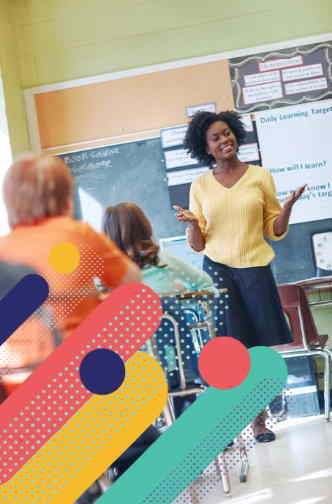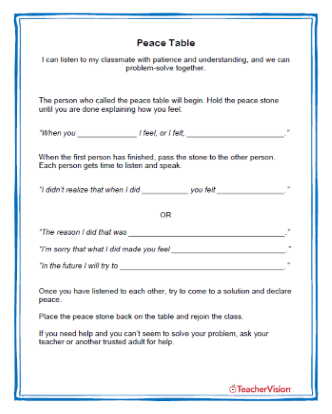The strategies in this playlist represent different activities and strategies that you can add into your existing daily routine and procedures. Each strategy is designed to provide students with an opportunity to solve problems, focus on process acumen, solicit assistance, and resolve conflict.
Strategy Name: No Opt Out |
|
| A strategy that helps students build the self-awareness to ask for help when facing challenges they can't solve on their own. | |
|
|
What Is It?No Opt Out is a simple strategy that holds students to a high expectation of participating. It is simple to implement and can be an important piece of classroom culture. Simply, no opt out means a student cannot opt out of answering a question. The problem solving piece comes in by providing structures and tools for students to use if they are stuck, or not ready to participate. Why Is It Important?It creates the high expectation that every student voice is important, and it provides students with tools for asking for help that they can use, not only in the classroom, but in the workplace and the community. How Can You Make It Happen?At the beginning of the year, set up the expectation that any student can be called on at any time. This helps develop the expectation that every student needs to be ready to participate. Create an anchor chart or poster with the tools students can use if they get stuck. These tools can include:
When Can You Use It?The great thing about this strategy is that it can be used at any time and in any class. It works great during discussions and the more you hold students to the expectation to use it, the more you will see them using it in class, in discussion and maybe even outside of your classroom. How Can You Stretch Students’ Thinking?In addition to holding students the expectation of answering, you can push them to explain and support their thinking with evidence and details. How Can You Modify And Support Students?You can always add more tools to the poster. Creating tools that help English Language Learners or students with auditory and processing differences will benefit all students, so don’t be afraid to include lots of strategies! Some examples of tools geared towards ELLs would be:
|
Strategy Name: Peace Table |
|
| A strategy to help students deal productively with conflict. | |
|
|
What Is It?A peace table is a conflict resolution tool. It provides structure for students to discuss a conflict they have and come to a solution or compromise. Why Is It Important?The practice of peace tables puts students in the uncomfortable position of facing a conflict head on while giving them the tools to do this respectfully. At all levels it helps students transition from tattling and fighting to conflict resolution by giving them language and structure for problem solving. How Can You Make It Happen?Create (or steal) Peace Table guidelines. Introduce peace tables at the beginning of the year and have students practice scenarios when they might use it. Anytime a conflict occurs, mediate peace tables with students. If you feel confident and are teaching older students, you can have them at the peace table on their own and check in with you after. When Can You Use It?This can be used anytime there’s a conflict in the classroom, whether it’s between two people or groups of people. I have even used it in class to play out conflict resolution in history, for example when the Native American chief Ouray compromised with the U.S. Army. How Can You Stretch Students’ Thinking?Ask students to speak in “I” terms. This moves the conversation’s focus away from blaming someone and onto how an action made someone feel. This helps students see what they have in common and is helpful in finding a solution, rather than making sure someone is to blame. How Can You Modify And Support Students?Creating a template with sentence starters and responses helps guide students through the peace table, especially if it is a new tool. |
Strategy Name: Kind, Specific Feedback |
|
| Help students become familiar and facile with structured peer-to-peer, teacher-to-student, or self-feedback. | |
|
|
What Is It?It is structured peer-to-peer, peer-to-self or teacher-to-student feedback that gives the recipient clear next steps for revision and editing. Why Is It Important?Research has proven that written and specific feedback helps students improve and grow. Using a structured approach to feedback allows students to work on clear next steps. It also gives students the language and structure to critique someone else’s work. Both revision and critiquing are skills that are valuable to problem solving in the classroom and beyond it. Using feedback cycles in the classroom also reinforces the expectation that high quality work is the goal, and that the first draft of something is not the final draft. How Can You Make It Happen?Define kind, specific feedback with students. Use clear and specific criteria or rubrics when designing assignments. This will give students the language to use when they are giving feedback. Practice using structures like stars and steps with students and showcase student feedback that meets the criteria for kind and specific. Finally, celebrate the students who apply the feedback to the revisions they make. When Can You Use It?You can use kind, specific feedback anytime both formally and informally. Using it across subjects and in multiple classes helps students practice the design process and use peer or teacher feedback to improve their skills. It helps to use it multiple times when working towards a finished product. This video helps demonstrate the powerful impact of multiple feedback cycles and revisions. How Can You Stretch Students’ Thinking?Students will be stretched already by looking at peer work with a critic’s eye, as well as being asked to give feedback that is specific. If students already understand kind, specific feedback, you can push them to begin giving feedback with 1-2 possible solutions or revisions that could help their peers. How Can You Modify And Support Students?Conferencing with students or providing opportunities for peer to peer conferencing will help students better understand the feedback they receive. This allows for students to ask questions and collaborate on revision ideas. Providing graphic organizers with the criteria for feedback and criteria or rubric for the task helps students use specific vocabulary and skills in their feedback. |







